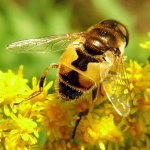Phylum Arthropoda (Arthropods) ➔ Subphylum Hexapoda (Hexapods) ➔ Class Insecta (Insects) ➔ Order Diptera (True flies) ➔ Family Syrphidae (Hoverflies)
Eristalis (Eoseristalis) arbustorum (Linnaeus, 1758)
Kleine Keilfleckschwebfliege
Synonyms and other combinations:
Eristalis bulgarica Szilady, 1934 | Eristalis polonica Szilady, 1934 | Eristalis sachalinensis Matsumura, 1916 | Eristalis strandi Duda, 1940 | Eristalomya distincta Shiraki, 1968 | Musca lyra Harris, 1776 | Musca nemorum Linnaeus, 1758 | Musca parralleli Harris, 1776 | Musca parrelleli Harris, 1776 | Syrphus deflagratus Preyssler, 1793 | Syrphus succinctus Panzer, 1804 | Volucella tricincta Müller, 1776 |
Classification:
Eristalis arbustorum belongs to the subfamily Eristalinae, tribe Eristalini.Distribution:
Throughout the Palaearctic region, including North Africa; North America from Wisconsin to Labrador and south to Kansas and South Carolina; reaches the Oriental region in northern India.Habitat:
Wetlands, alluvial forest, parks, gardens, farmland.Description:
Eristalis arbustorum has a body length of 9 - 11 mm. The eyes of the males are touching. The face is completely white hairy. Only with old flies it may show a bald narrow middle stripe. The antennae are brown or black. The arista is clearly feathered. The yellowish spots on the 2nd abdominal segment are dull. Front and middle tibia are at least partially black. The wing stigma is less than 3 times as long as it is wide.In the similar Eristalis abusiva the eyes of the males are separated by a narrow space and the arista does not have long hairs.
Biology:
Eristalis arbustorum flies in several generations from March to November. It prefers to live in open habitats.Larvae were found in different aquatic environments with decomposing organic matter.
References, further reading, links:
- Pape T. & Thompson F.C. (eds) (2017). Systema Dipterorum (version 2.0, Jan 2011). In: Species 2000 & ITIS Catalogue of Life, 2017 Annual Checklist (Roskov Y., Abucay L., Orrell T., Nicolson D., Bailly N., Kirk P.M., Bourgoin T., DeWalt R.E., Decock W., De Wever A., Nieukerken E. van, Zarucchi J., Penev L., eds.). Digital resource at www.catalogueoflife.org/annual-checklist/2017. Species 2000: Naturalis, Leiden, the Netherlands. ISSN 2405-884X.
- M.C.D.Speight: Species Accounts of European Syrphidae (Diptera), Glasgow 2011, Syrph the Net, the database of European Syrphidae, vol. 65, 285 pp., Syrph the Net publications, Dublin.
- Gerald Bothe: Bestimmungsschlüssel für die Schwebfliegen (Diptera, Syrphidae) Deutschlands und der Niederlande, DJN, 1984, ISBN 3-923376-07-3
- Menno Reemer, Willem Renema, Wouter van Steenis, Theo Zeegers, Aat Barendregt, John T. Smit, Mark P. van Veen, Jeroen van Steenis, Laurens van der Leij: De Nederlandse Zweefvliegen (Diptera: Syrphidae), Nederlandse Fauna 8, 2009.
- Speight, M.C.D. & Sarthou, J.-P. (2014) StN keys for the identification of the European species of various genera of Syrphidae (Diptera) 2014 / Clés StN pour la détermination des espèces Européennes de plusieurs genres des Syrphidae (Diptères) 2014. Syrph the Net, the database of European Syrphidae, Vol. 80, 125 pp, Syrph the Net publications, Dublin
- Anasimyia interpuncta
- Anasimyia transfuga
- Baccha elongata
- Brachyopa sp.
- Brachypalpoides lentus
- Brachypalpus laphriformis
- Brachypalpus sp.
- Brachypalpus valgus
- Ceriana conopsoides
- Ceriana vespiformis
- Chalcosyrphus femoratus
- Chalcosyrphus nemorum
- Chalcosyrphus valgus
- Cheilosia albipila
- Cheilosia albitarsis
- Cheilosia chrysocoma
- Cheilosia illustrata
- Cheilosia pagana
- Cheilosia scutellata
- Cheilosia sp.
- Chrysogaster sp.
- Chrysotoxum bicinctum
- Chrysotoxum fasciatum
- Chrysotoxum festivum
- Chrysotoxum verralli
- Criorhina berberina
- Dasysyrphus albostriatus
- Dasysyrphus sp.
- Dasysyrphus tricinctus
- Didea fasciata
- Didea intermedia
- Didea sp.
- Epistrophe diaphana
- Epistrophe eligans
- Epistrophe flava
- Epistrophe grossulariae
- Epistrophe melanostoma
- Epistrophe melanostoma/nitidicollis
- Epistrophella euchroma
- Eristalinus megacephalus
- Eristalis arbustorum
- Eristalis interrupta
- Eristalis intricaria
- Eristalis lineata
- Eristalis rupium
- Eristalis similis
- Eristalis sp.
- Eumerus purpurariae
- Eumerus sp.
- Eupeodes corollae
- Eupeodes luniger
- Eupeodes sp.
- Ferdinandea cuprea
- Helophilus hybridus
- Helophilus sp.
- Helophilus trivittatus
- Ischiodon aegyptius
- Leucozona glaucia
- Leucozona laternaria
- Leucozona lucorum
- Melangyna lasiophthalma
- Melangyna quadrimaculata
- Melangyna umbellatarum
- Melanogaster sp.
- Melanostoma scalare
- Meligramma triangulifera
- Meliscaeva cinctella
- Merodon ambiguus
- Merodon avidus
- Merodon moenium
- Merodon obscuritarsis
- Merodon sp.
- Microdon analis/major
- Microdon mutabilis/myrmicae
- Myolepta dubia
- Orthonevra sp.
- Paragus sp.
- Parasyrphus lineolus
- Parhelophilus sp.
- Pipiza austriaca
- Pipiza bimaculata
- Pipiza fenestrata
- Pipiza quadrimaculata
- Pipiza sp.
- Platycheirus rosarum
- Platycheirus sp.
- Rhingia rostrata
- Scaeva albomaculata
- Scaeva selenitica
- Sericomyia lappona
- Sphaerophoria rueppelli
- Sphaerophoria sp.
- Sphegina sp.
- Spilomyia saltuum
- Syrphus sp.
- Syrphus vitripennis
- Temnostoma bombylans
- Temnostoma meridionale
- Temnostoma vespiforme
- Tropidia scita
- Xanthogramma citrofasciatum
- Xanthogramma pedissequum
- Xylota segnis
- Xylota sp.
- Xylota sylvarum
- Aspen Hoverfly
- Band-eyed Drone Fly
- Bumblebee Hoverfly
- Common Bog Hoverfly
- Common Drone Fly
- Common Snout-hoverfly
- Deadhead Hover Fly
- Figwort Cheilosia
- Hornet Mimic Hoverfly
- Large Hoverfly
- Large Narcissus Fly
- Larger Spotty-eyed Drone Fly
- Long Hoverfly
- Marmalade Fly
- Pied Hoverfly
- Pine Hoverfly
- Snouted Duckfly
- Summer Fly
- Sun Fly
- Tapered Drone Fly
- Thick legged Hoverfly
- White-banded Drone Fly




